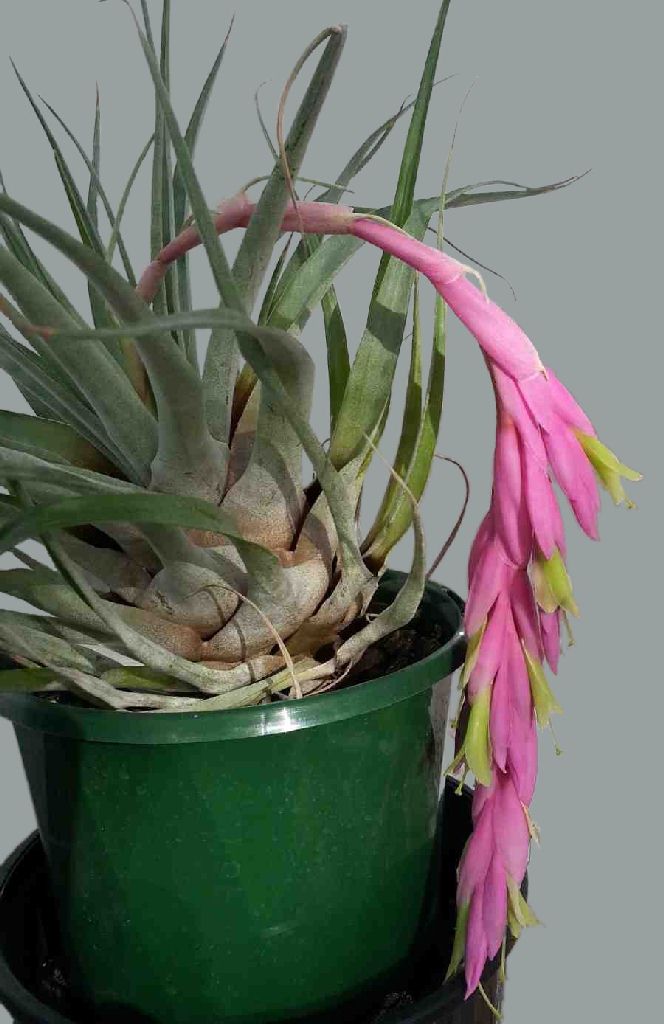
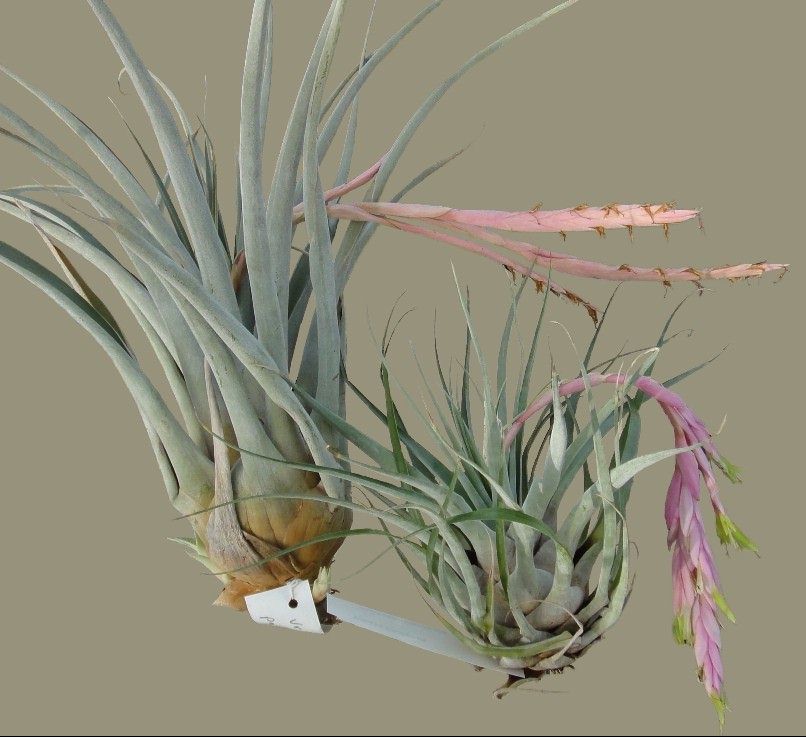
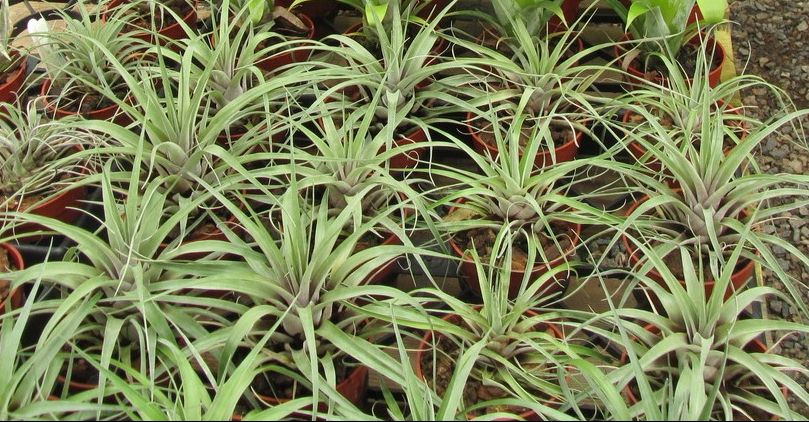
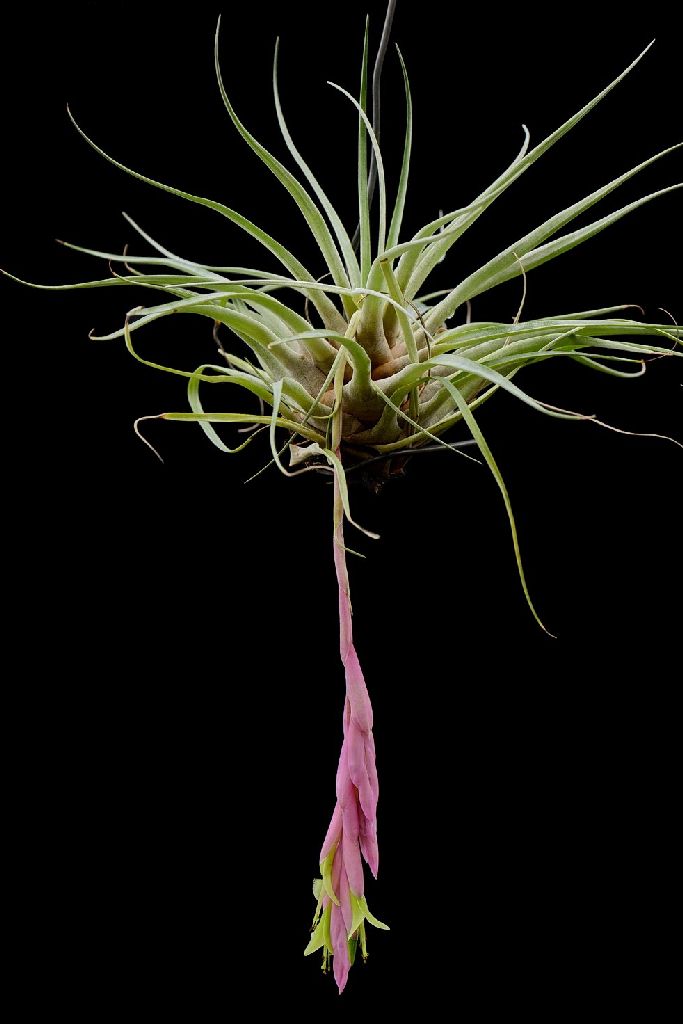
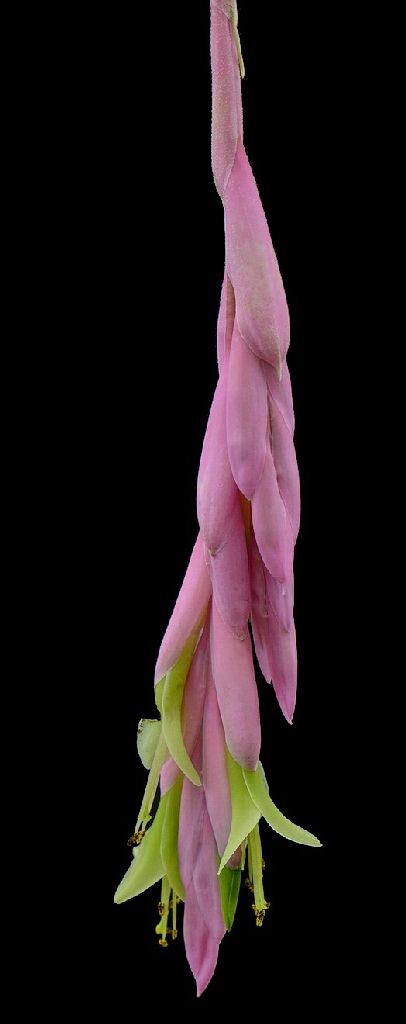
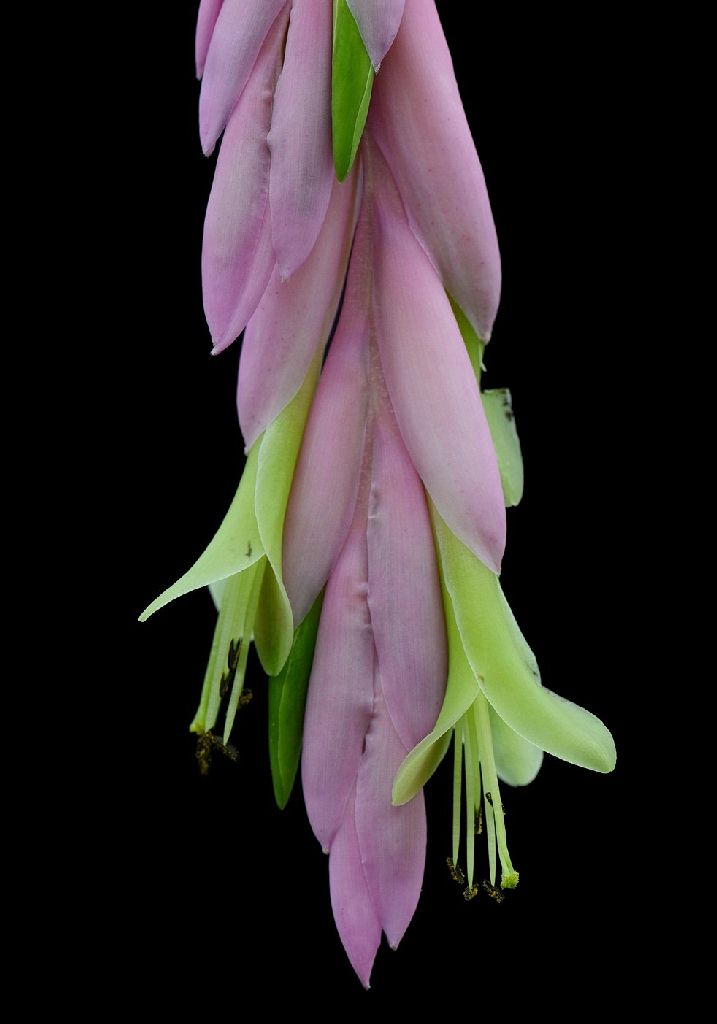
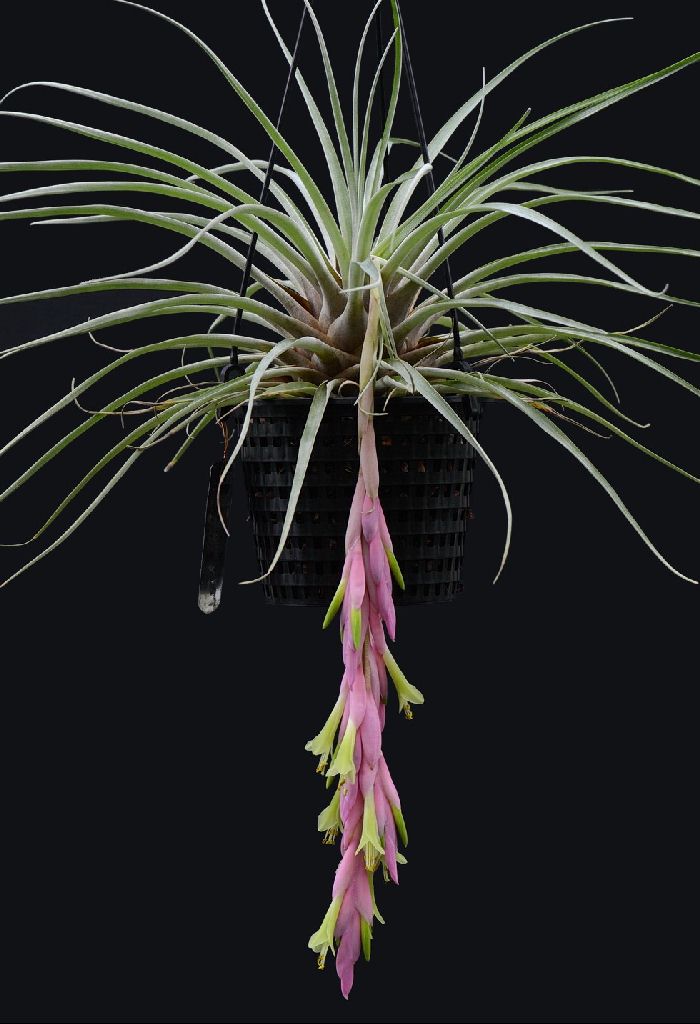
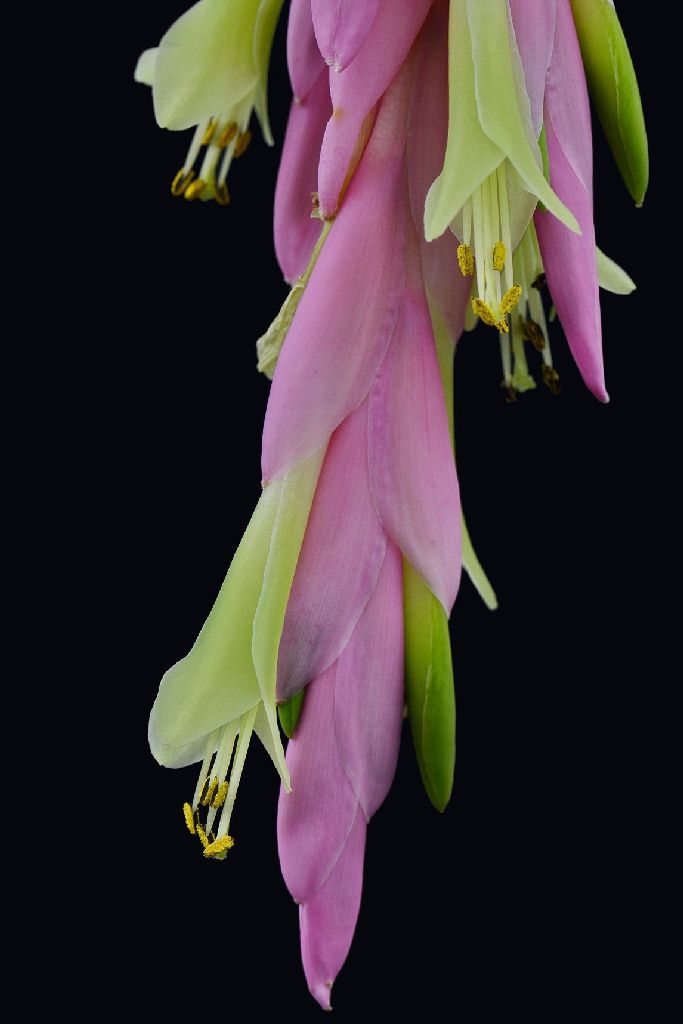
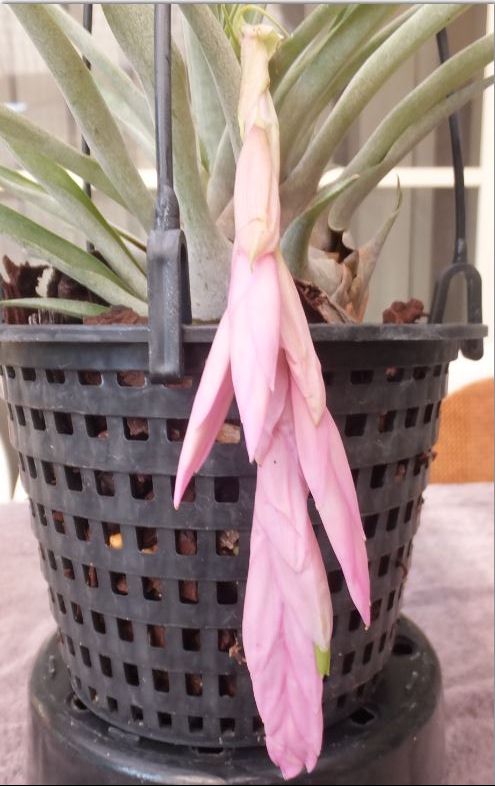
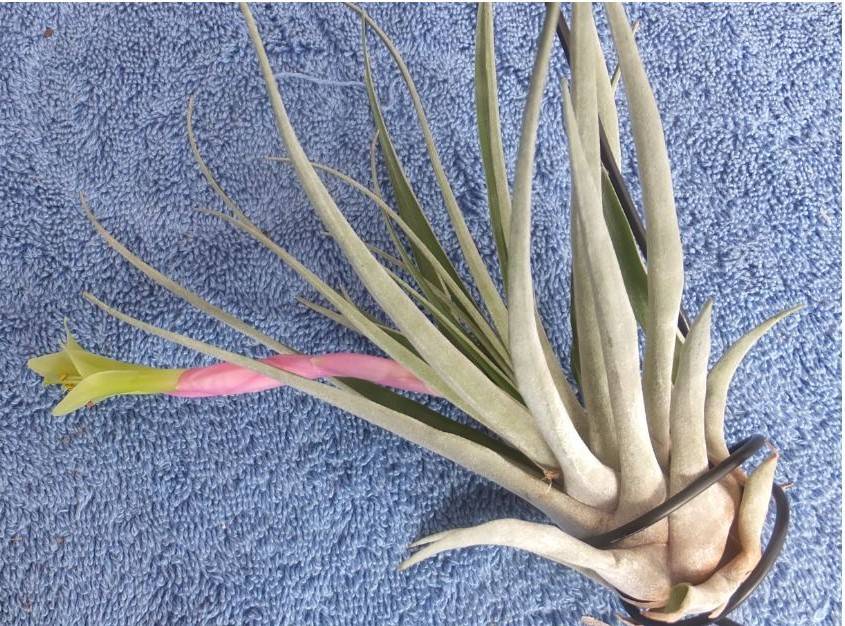
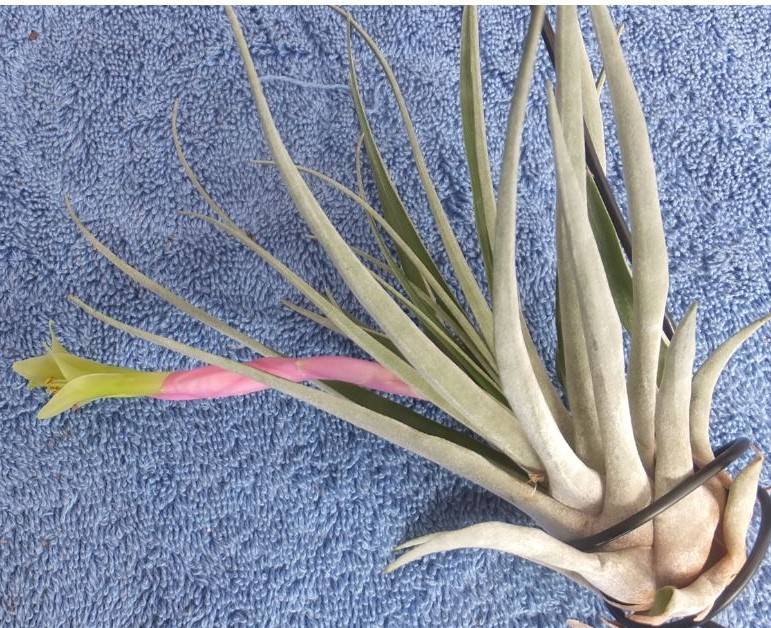
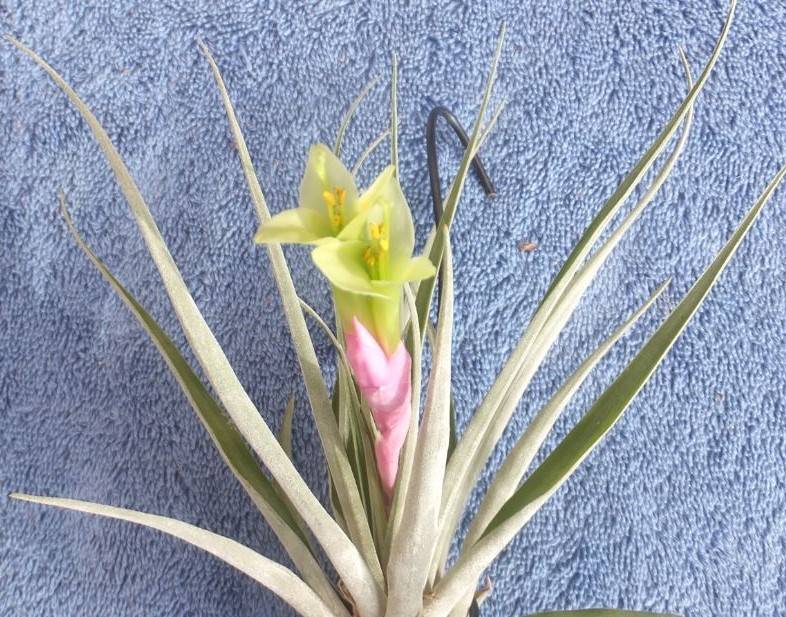
Planta acaulis usque ad 30cm alta. Folia numerosa, erecta vaginis pseudobulbum 10-15cm diametientem formantia. Vaginae distincte limitatae cochleariformes, 10cm longae, 9cm.latae utrimque atrocastaneo-lepidotae. Lamina anguste triangularis, longe acuminata 15-20cm longa, supra vaginam 3cm lata, utrimque dense cano-lepidota. Scapus inflorescentiae pendulus, 18cm longus, 6mm diametiens, foliis rosulae brevior. Phylla scapi basalia subfoliata, superiora tantum lamina brevi lineali, vagina magna amplexicauli rosea cano-lepidota internodiis longior, inflorescentia itaque cylindrica, plus minusve 25cm longa, 3-4mm diametiens. Rhachis viridis, angulata brunneo-lanata. Bracteae primariae 3-4cm longae erectae, 1-1.5cm latae, acuminatae leves, rufae, disperse lepidotae, multo breviores quam spicae; eae 7-9cm longae complanatae, 1.5cm latae, 5-ve16-florae, parte basali sterili brevi 2cm longa et axe spadiceo-lepidota; axis basi (sicco omnino) visibilis. Bracteae florales 4.5cm longae, 1,4cm latae, distincte carinatae, disperse cano-lepidotae, erectae, axi appressae, laete carmineae. Sepala multo breviora quam bracteae florales, 2.1cm longa, 6mm lata apice rosea, basim versus viridia, usque ad basim libera (sicco distincte nervata), indistincte carinata. Petala 5cm longa, 5mm lata, viridia, apices lanceolati paulum divaricati, basi lepidibus 2 magnis. Stamina antheris luteis circiter tam longa quam petala; stylus cum stigmatibus paulum exsertus. s. Bromelienstudien 6. Mitteilung, S. 21 (1976) Bromelienstudien 5. Mitteilung, S. 53 (1976)
Pflanze stammlos, bis 30cm hoch. Blatter zahlreich, aufrecht, mit ihren Scheiden eine Scheinbulbe von 10-15cm Durchmesser bildend (Abb. 11, links). Scheiden deutlich abgesetzt, loffelformig, 10cm lang, 9cm breit, beiderseits dunkelkastanienbraun beschuppt. Spreite schmal-3-eckig, lang zugespitzt, 15-20cm lang, oberhalb der Scheide 3cm breit, beiderseits dicht grau lepidot. Infloreszenzschaft hangend, 18cm lang, 6mm dick, kurzer als die Rosettenblatter (Abb. ll, links). Schaftbrakteen: die basalen subfoliat, die oberen nur mit kurzer, linealer Spreite und grosser, schaftumfas¬sender, rosafarbiger, grau beschuppter Scheide, langer als die Internodien. Infloreszenz hangend, locker bipinnat, mit ± 7 polystich angeordneten, der Rhachis anliegenden Ahren; Infloreszenz deshalb zylindrisch, ca. 25cm lang und 3-4cm dick (Abb. 11, links). Rhachis grun, kantig, braunwollig behaart. Primarbrakteen 3-4cm lang, aufrecht, 1-1.5cm breit, zugespitzt, glatt, rot, zerstreut beschuppt, viel kurzer als die Ahren. Diese 7-9cm lang, complanat, 1.5cm breit, 5- bis 6-blutig, mit kurzem, 2cm langem, sterilem Basalabschnitt und hellbraun lepidoter Achse ; diese an der Basis (getrocknet in der ganzen Lange) sichtbar. Florale Brakteen 4.5cm lang, 1.4cm breit, deutlich carinat, zerstreut grau lepidot, aufrecht, der Achse anliegend, lebhaft karminrot. Sepalen viel kurzer als die floralen Brakteen, 2.1cm lang, 6mm breit, an der Spitze rosafarbig, zur Basis hin grun, bis zum Grunde frei (getrocknet stark genervt), undeutlich carinat. Petalen 5cm lang, 5mm breit, grun, ihre lanzettlichen Spitzen wenig auseinanderweichend (Abb. 11, rechts), an der Basis mit 2 grossen Schuppen. Staubblatter mit gelben Pollensacken, etwa so lang wie die Petalen; Griffel mit den grunen Narben wenig herausragend (Abb. 11, rechts).
Holotypus : RAUH 53 092, Juni 1980, im (HEID.)
Heimat und Verbreitung: Epiphytisch im Bergwald bei Limon (Indanza), zwischen Paute und Mendez (Prov. Azuay, Sudecuador), 1000 m.
Vriesea limonensis, besonders auffallig durch ihre schlaff-hangenden, roten Infloreszenzen, wachst in Bergwaldern bei Limon (Prov. Azuay) in Gesell¬schaft von Vriesea penduliscapa RAUH
und Neoregelia aculeato-sepala RAUH
. Nach dem Bromelienbestimmungsschlussel von L. B. SMITH (Subkey I) gelangt man zu Vriesea olmosana (s. S. 28), bei der zuweilen auch Pflanzen,mit hangenden Infloreszenzen angetroffen werden, doch weisen these zu V. limonensis keine verwandtschaftlichen Beziehungen auf. Hangende bzw. abwarts gebogene Infloreszenzen haben auch die in Ecuador verbreiteten V. arpocalyx (ANDRE) L. B. SMITH und V. tequendamae (ANDRE) L. B. SMITH (s. Abb. 12), doch sind bei diesen die Primarbrakteen fast so lang wie die Ahren, bei V. limonensis jedoch viel kurzer. Die in Kolumbien verbreitete V. pereziana (ANDRE) L. B. SMITH hat gleichfalls hangende, jedoch subpinnate Infloreszenzen mit spreizenden floralen Brakteen, sehr locker angeordneten Bluten und weit herausragenden Staubblattern.
V. limonensis ist bisher nur vom Typstandort bekannt.
Translated by Butcher
Plant stemless, to 30cm high, leaves numerous, erect, with the sheath forming a bulb 10-15cm diam.
Leaf sheath distinct, spoon shaped, 10cm long, 9cm wide, both sides dark chestnut brown scaled.
Leaf blade thin triangular, long acuminate, 15-20cm long, 3cm wide near sheath, both sides dense grey lepidote.
Scape hanging, 18cm long, 6mm thick, shorter than the leaf rosette,
Scape bracts bottom ones leaf like, the upper with short lineal blade and larger, extensively covered, pink coloured, grey scaled, sheath, longer than the internodes.
Inflorescence hanging, laxly bipinnate, with ca. 7 polystichous spikes adjacent to the rhachis, for that reason the inflorescence is cylindric, ca. 25cm long, 3-4cm diam.
Rhachis green, edged, with brown woolly hairs.
Primary bract 3-4cm long, erect, 1-1.5cm wide, acuminate, smooth, red, scattered scales, much shorter than the spike.
Spike 7-9cm long, complanate, 1.5cm wide, 5-6 flowered, with short 2cm long, sterile bottom section, light brown scaled, rhachis visible at base (when dry the whole length is visible)
Flower bract 4.5cm long, 1.4cm wide, clearly keeled, scattered grey lepidote, erect, adjacent to the rhachis, lively carmine red.
Sepals much shorter than the floral bracts, 2.1cm long, 6mm wide, pink colour at the tip and green at the base, free, (when dry strongly nerved), indistinctly keeled.
Petals 5cm long, 5mm wide, green, the lance tip slightly separated, 2 large scales at the base.
Stamens with yellow pollen sacs, as long as the petals Style with green lobes protrudes a little.
Type Locality Epiphytic, in the hills near Limon, ( Indanza ) between Paute and Mendez ( Prov. Azuay, South Ecuador ) 1000m alt.
Holotype Rauh 53 092, June 1980 HEID
Vriesea limonensis, particularly noticeable by its limp hanging, red inflorescence, grows in the mountains near Limon (Prov. Azuay), with Vriesea penduliscapa Rauh {see Bromelienstudien 6. Mitteilung S., 21,(1976)} and Neoregelia aculeato-sepala Rauh {Bromelienstudien 5. Mitteilung, S., 53 (1976)}. Using the Key L. B. Smith (Subkey I) you reach Vriesea olmosana (See page 28), with which occasionally this plant with hanging inflorescence is found, but this has no relationship to V. limonensis. Hanging as well as downward bending inflorescence occur in Ecuador with V. arpocalyx (Andre) L. B. Smith and V. tequendamae (Andre) L. B. Smith (See Fig. 12), however the primary bracts with these are virtually as long as the spike, but much shorter in V. limonensis. V. pereziana (Andre) L. B. Smith dispersed in Colombia has hanging inflorescences likewise, but with a subpinnate inflorescence with spreading floral bracts, very lax flowers and widely protruding stamens.
V. limonensis is known only from the Type locality until now.